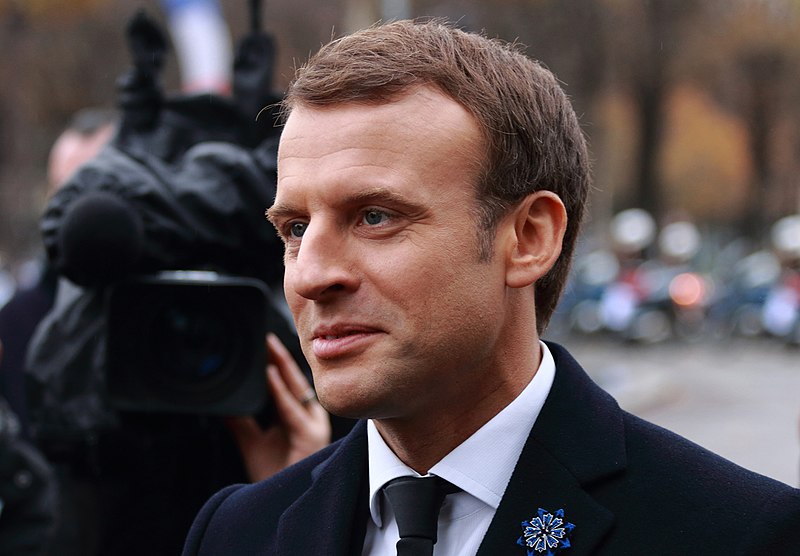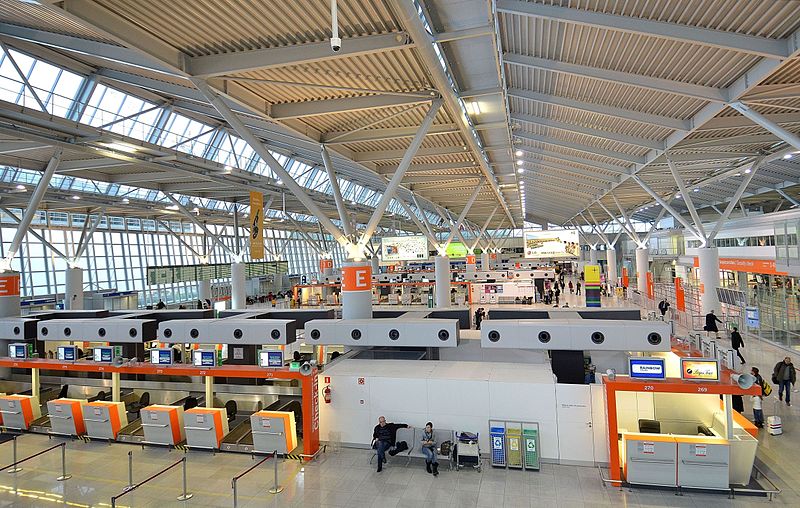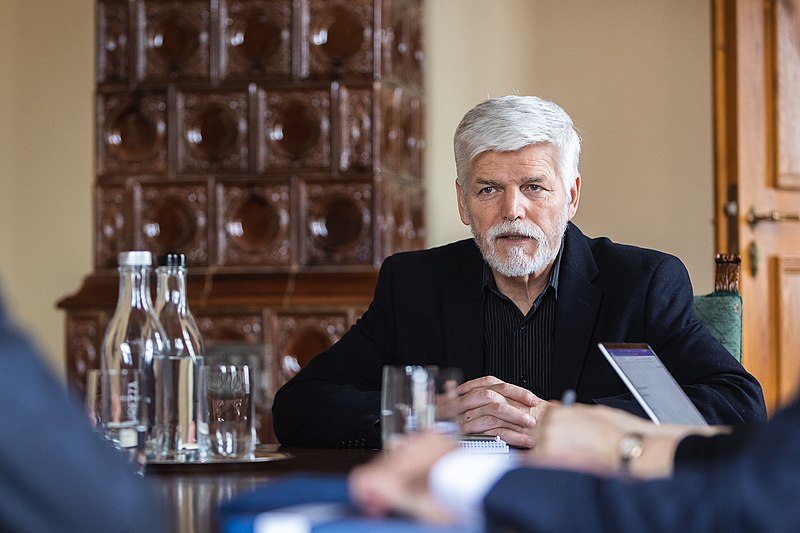
Is the EU ready for a common foreign policy?
February 19, 2014
11th annual Black History Symposium Feb. 19-20 to focus on sport, media, race
February 20, 2014
.cnn_html_media_utility::before{color:red;content:’>>’;font-size:9px;line-height:12px;padding-right:1px}
.cnnstrylccimg640{margin:0 27px 14px 0}
.captionText{filter:alpha(opacity=100);opacity:1}
.cnn_html_slideshow_media_caption a,.cnn_html_slideshow_media_caption a:visited,.cnn_html_slideshow_media_caption a:link,.captionText a,.captionText a:visited,.captiontext a:link{color:outline:medium none}
.cnnVerticalGalleryPhoto{margin:0 auto;padding-right:68px;width:270px}
]]>
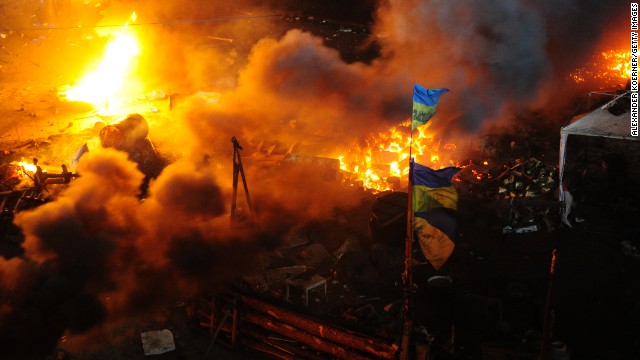 The central square in the capital of Ukraine is engulfed in flames during clashes between protesters and riot police early on Wednesday, February 19. Thousands of anti-government demonstrators have packed Independence Square since November, when President Viktor Yanukovych reversed a decision to sign a trade deal with the European Union and instead turned toward Russia.
The central square in the capital of Ukraine is engulfed in flames during clashes between protesters and riot police early on Wednesday, February 19. Thousands of anti-government demonstrators have packed Independence Square since November, when President Viktor Yanukovych reversed a decision to sign a trade deal with the European Union and instead turned toward Russia.
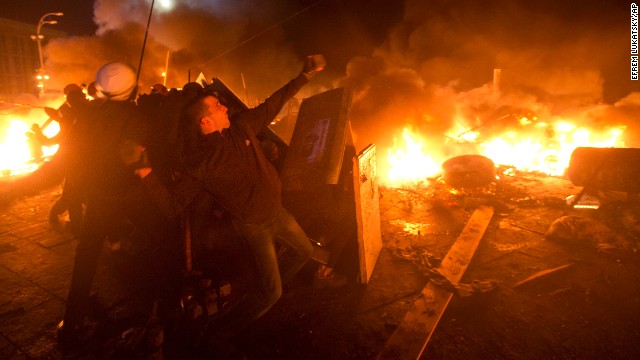 Protesters clash with riot police in Kiev’s Independence Square on Tuesday, February 18.
Protesters clash with riot police in Kiev’s Independence Square on Tuesday, February 18.
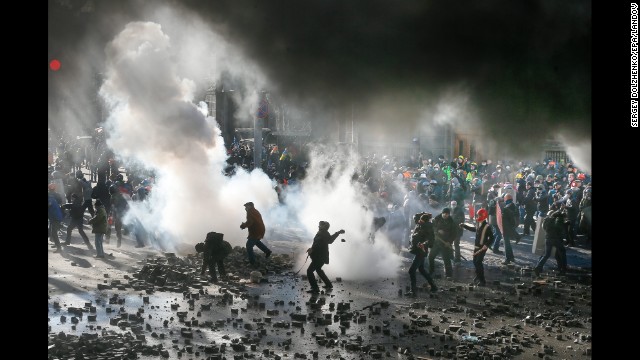 Protesters fight with riot police during a new wave of violent clashes February 18 in Kiev.
Protesters fight with riot police during a new wave of violent clashes February 18 in Kiev.
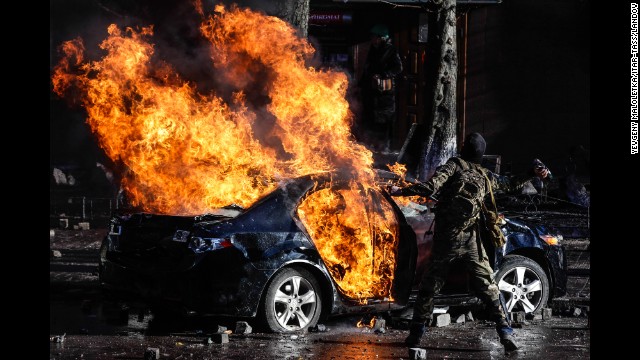 Protesters burn a car in central Kiev on February 18.
Protesters burn a car in central Kiev on February 18.
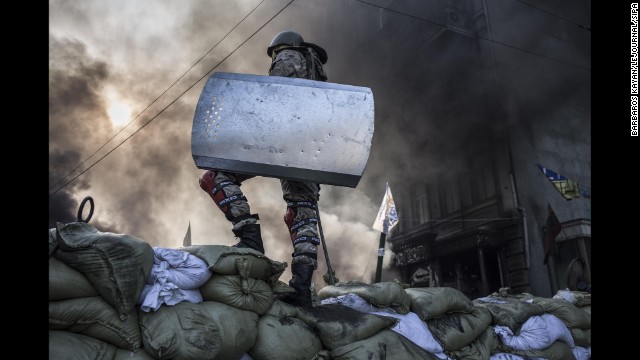 A protester stands atop a barricade in Kiev on February 18.
A protester stands atop a barricade in Kiev on February 18.
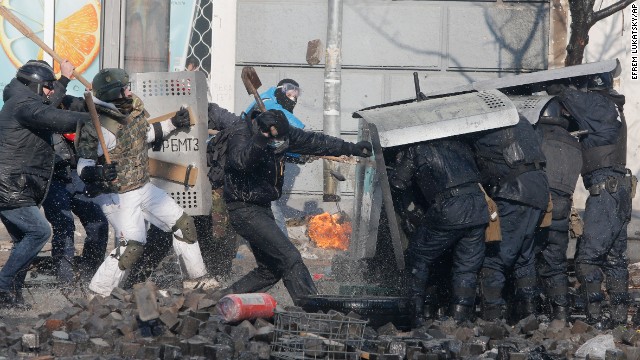 Anti-government protesters clash with riot police outside Ukraine’s parliament in Kiev on February 18.
Anti-government protesters clash with riot police outside Ukraine’s parliament in Kiev on February 18.
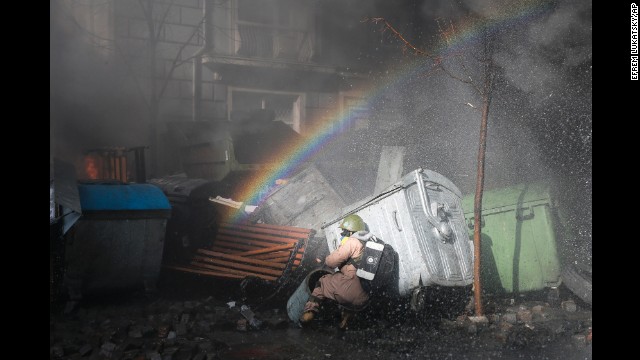 A rainbow forms over a protester ducking for cover in Kiev on February 18.
A rainbow forms over a protester ducking for cover in Kiev on February 18.
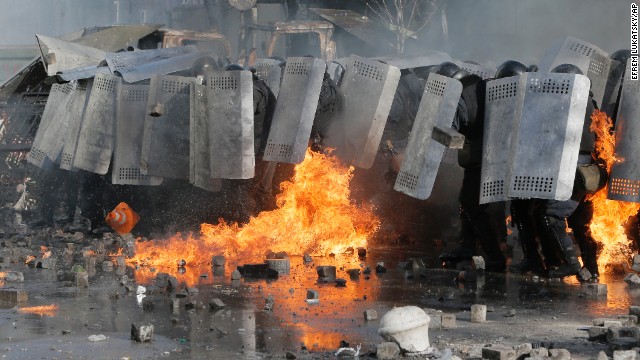 Riot police protect themselves during clashes in Kiev on February 18.
Riot police protect themselves during clashes in Kiev on February 18.
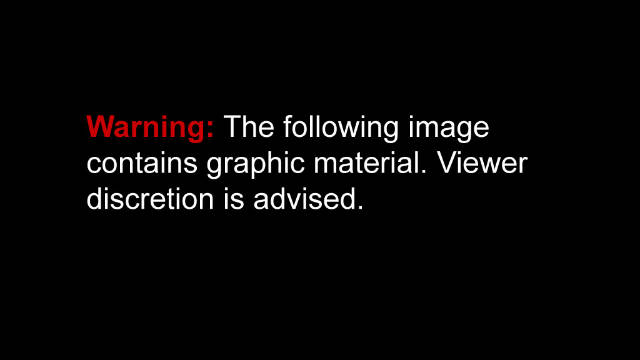
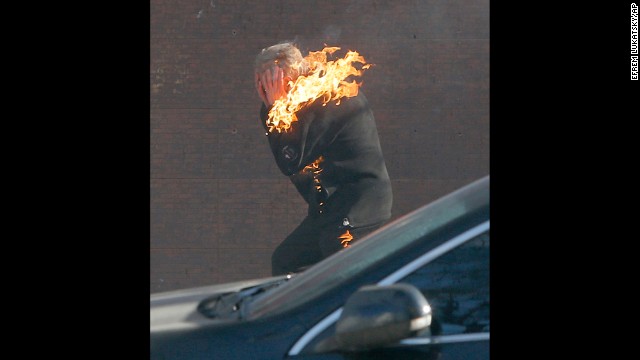 A protester is engulfed in flames while running from the clashes in Kiev on February 18.
A protester is engulfed in flames while running from the clashes in Kiev on February 18.
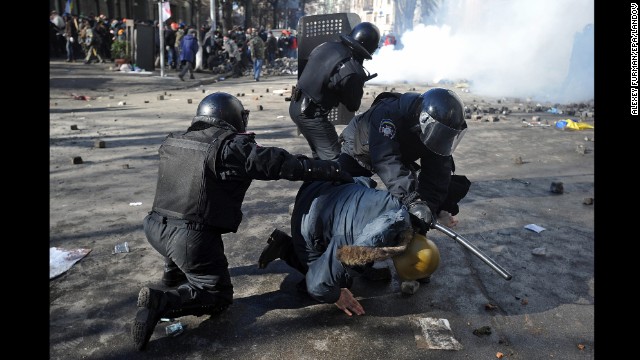 Riot police detain a protester in Kiev on February 18.
Riot police detain a protester in Kiev on February 18.
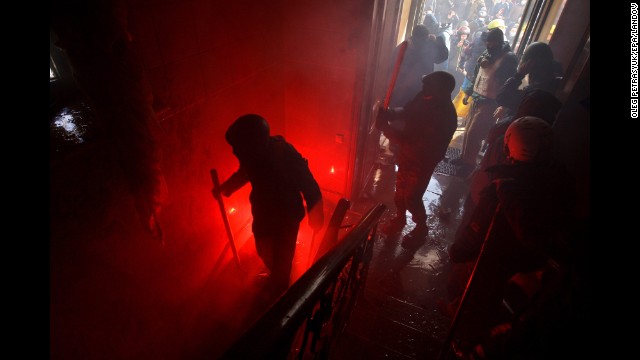 Protesters invade the main office of the ruling Party of Regions in Kiev on February 18.
Protesters invade the main office of the ruling Party of Regions in Kiev on February 18.
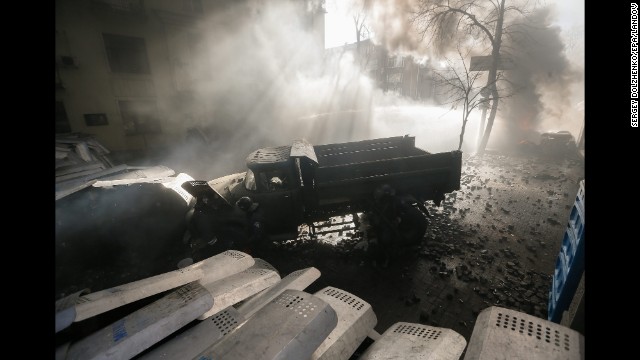 Riot police shield themselves during clashes with protesters on February 18.
Riot police shield themselves during clashes with protesters on February 18.
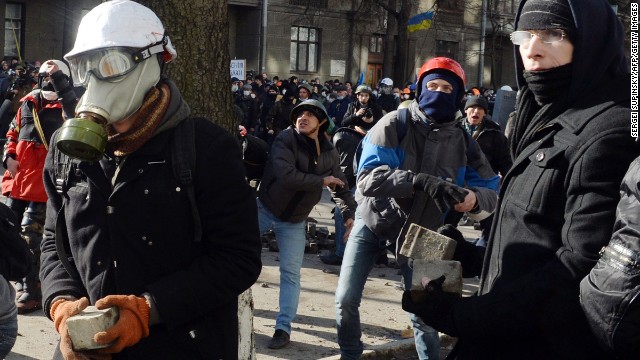 Protesters throw stones toward riot police in Kiev on February 18.
Protesters throw stones toward riot police in Kiev on February 18.
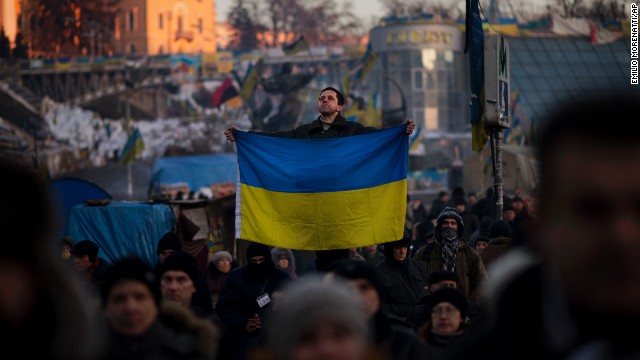 A protester holds a Ukrainian flag in Independence Square on Tuesday, February 4.
A protester holds a Ukrainian flag in Independence Square on Tuesday, February 4.
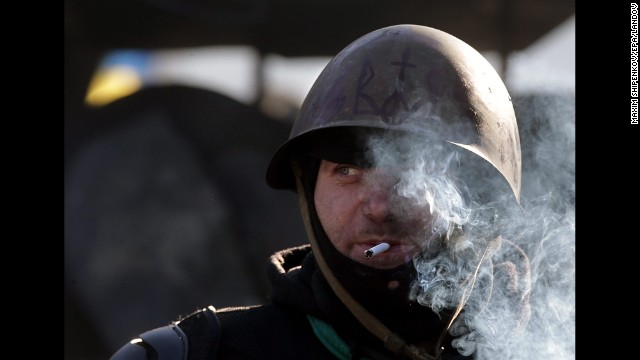 A protester smokes a cigarette while standing guard in Kiev on February 4.
A protester smokes a cigarette while standing guard in Kiev on February 4.
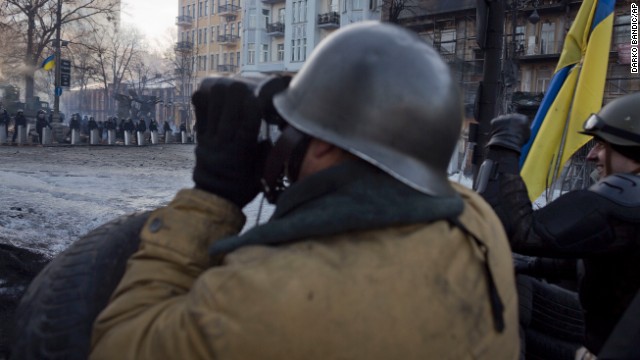 Protesters keep an eye on police February 4 as they man a barricade in Kiev.
Protesters keep an eye on police February 4 as they man a barricade in Kiev.
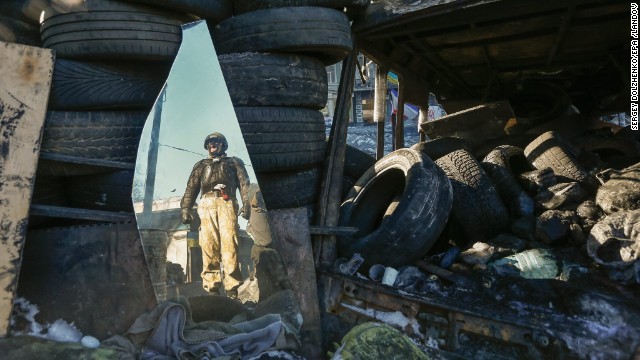 A protester is reflected in a broken mirror during protests in Kiev on Monday, February 3.
A protester is reflected in a broken mirror during protests in Kiev on Monday, February 3.
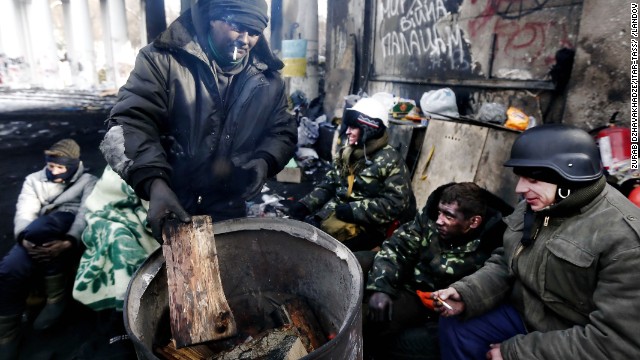 Opposition supporters warm themselves in Kiev on Saturday, February 1.
Opposition supporters warm themselves in Kiev on Saturday, February 1.
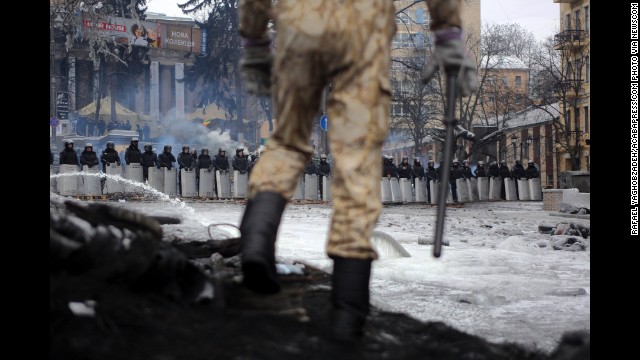 A protester stands on top of barricades in Kiev on Tuesday, January 28.
A protester stands on top of barricades in Kiev on Tuesday, January 28.
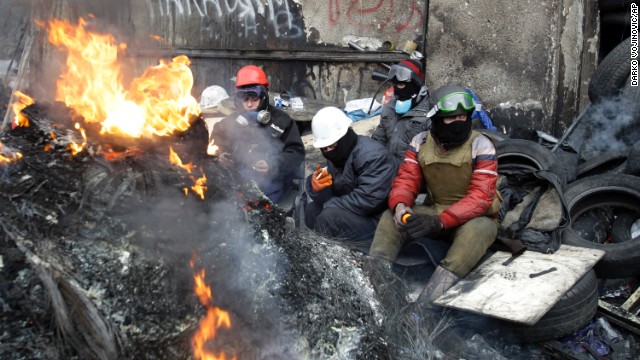 Protesters sit behind a barricade in Kiev on January 28.
Protesters sit behind a barricade in Kiev on January 28.
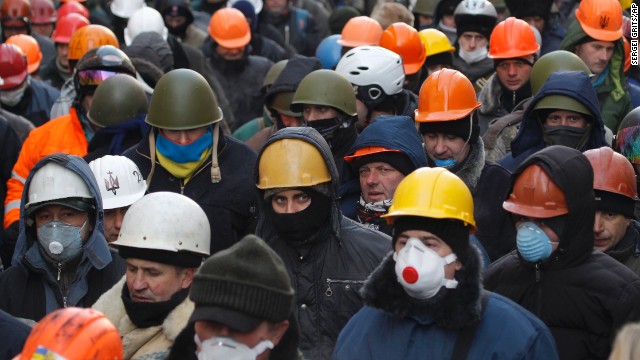 Protesters march in Kiev on Monday, January 27. Activists say they want wide-ranging constitutional reform and a shake-up of the Ukrainian political system.
Protesters march in Kiev on Monday, January 27. Activists say they want wide-ranging constitutional reform and a shake-up of the Ukrainian political system.
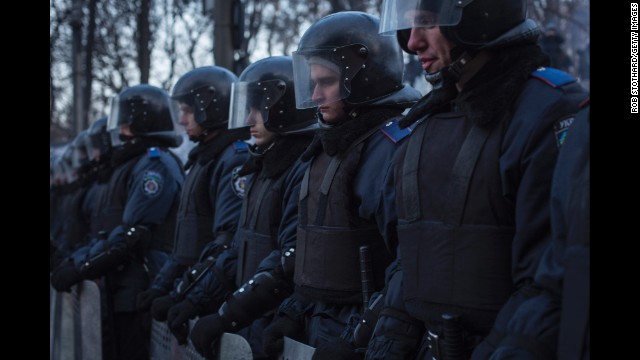 Police block a street in Kiev on January 27.
Police block a street in Kiev on January 27.
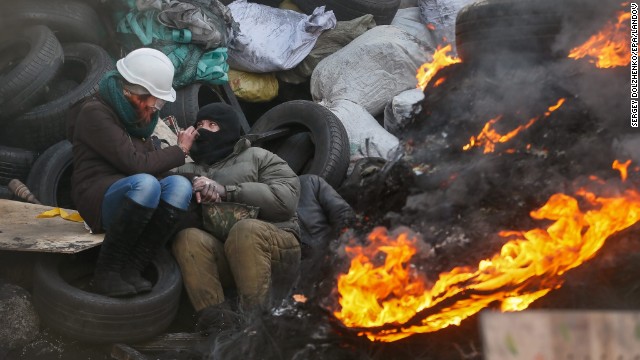 A couple try to keep warm near a fire at a barricade in Kiev on January 27.
A couple try to keep warm near a fire at a barricade in Kiev on January 27.
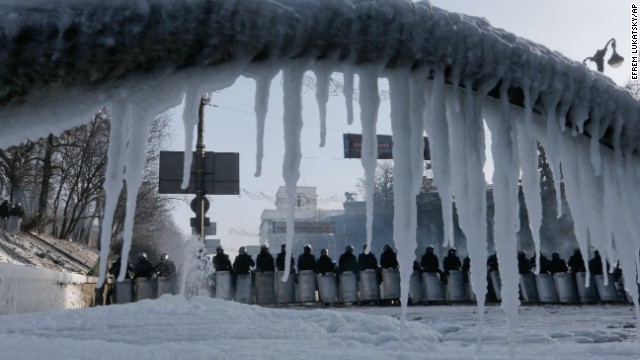 Riot police block a Kiev street from protesters on January 27.
Riot police block a Kiev street from protesters on January 27.
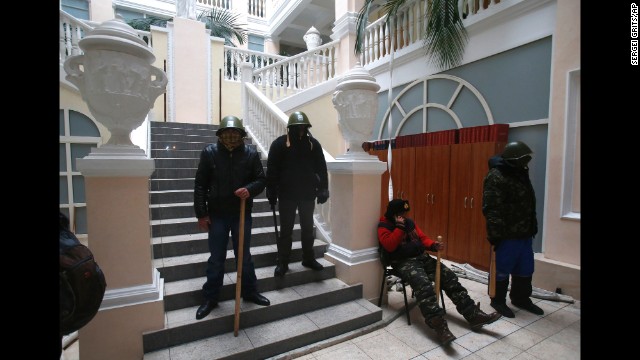 Protesters stand guard inside the Ukraine Justice Ministry in Kiev on January 27. Demonstrators later left the building because they didn’t want to create any difficulties in negotiations between the government and opposition, a protest leader said. Protesters repositioned themselves outside and blocked access to the building, the leader said.
Protesters stand guard inside the Ukraine Justice Ministry in Kiev on January 27. Demonstrators later left the building because they didn’t want to create any difficulties in negotiations between the government and opposition, a protest leader said. Protesters repositioned themselves outside and blocked access to the building, the leader said.
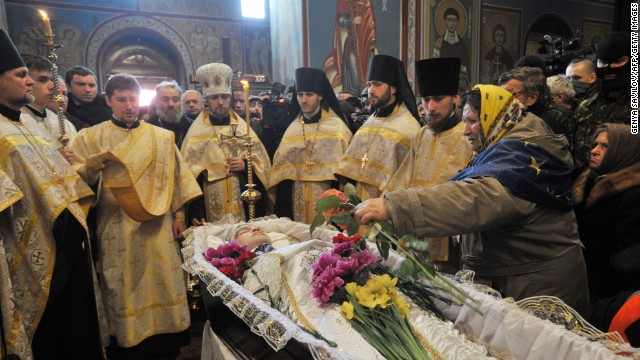 Orthodox priests lead the funeral service for slain protester Mikhail Zhiznevsky in Kiev on Sunday, January 26.
Orthodox priests lead the funeral service for slain protester Mikhail Zhiznevsky in Kiev on Sunday, January 26.
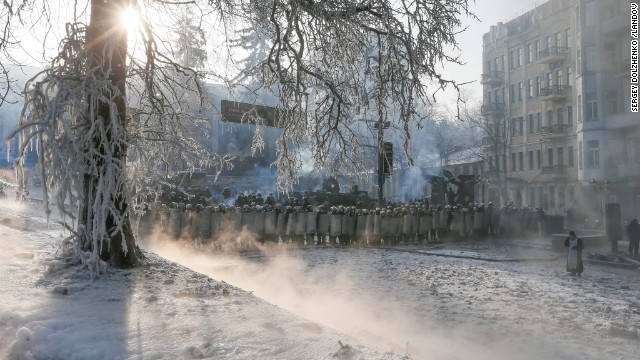 Riot police officers stand in line during anti-government protests in Kiev on Saturday, January 25.
Riot police officers stand in line during anti-government protests in Kiev on Saturday, January 25.
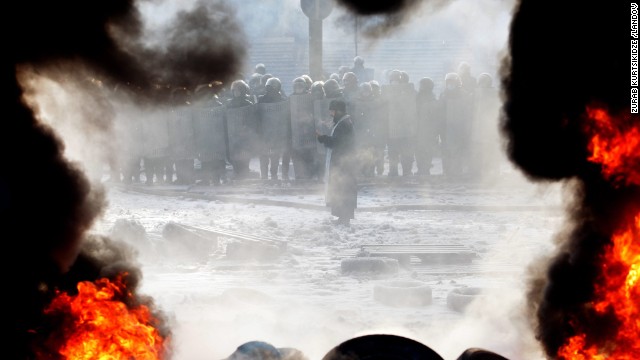 An Orthodox priest prays during protests on January 25.
An Orthodox priest prays during protests on January 25.
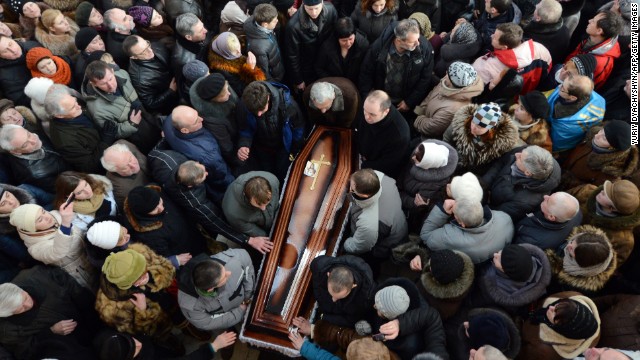 Some 10,000 Ukrainians take part in the funeral ceremony of dead protester Yuri Verbytsky in the western city of Lviv on Friday, January 24.
Some 10,000 Ukrainians take part in the funeral ceremony of dead protester Yuri Verbytsky in the western city of Lviv on Friday, January 24.
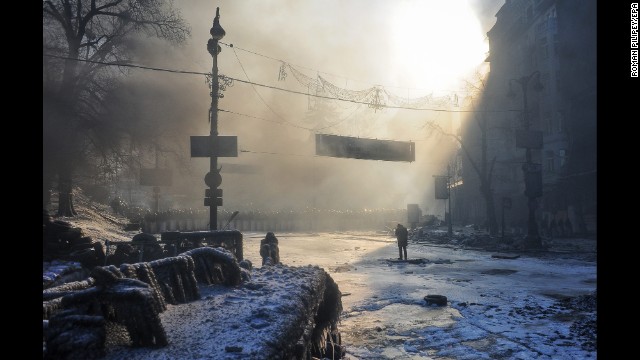 A line of Ukrainian riot police block a road on January 24.
A line of Ukrainian riot police block a road on January 24.
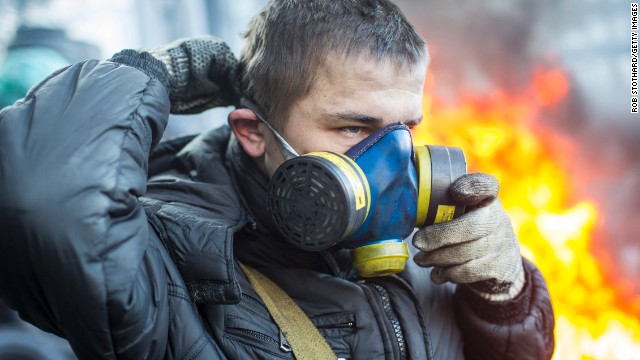 A protester puts on a gas mask near Dynamo Stadium in Kiev on January 24.
A protester puts on a gas mask near Dynamo Stadium in Kiev on January 24.
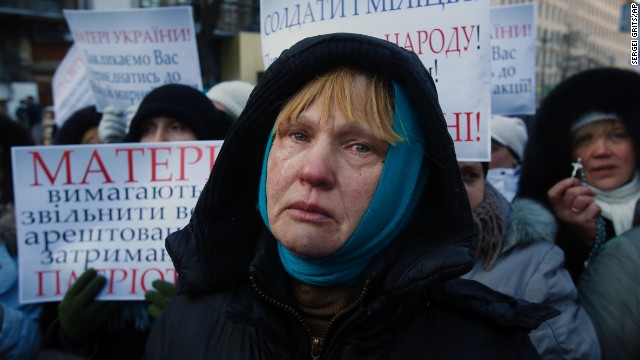 Ukrainian Oksana Tikhomirova cries as she urges riot police to stop the violence outside a government district in central Kiev on January 24.
Ukrainian Oksana Tikhomirova cries as she urges riot police to stop the violence outside a government district in central Kiev on January 24.
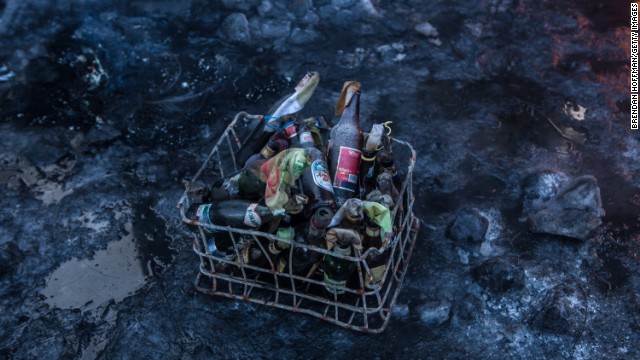 Molotov cocktails sit in a basket ready to be used by protesters in Kiev on January 24.
Molotov cocktails sit in a basket ready to be used by protesters in Kiev on January 24.
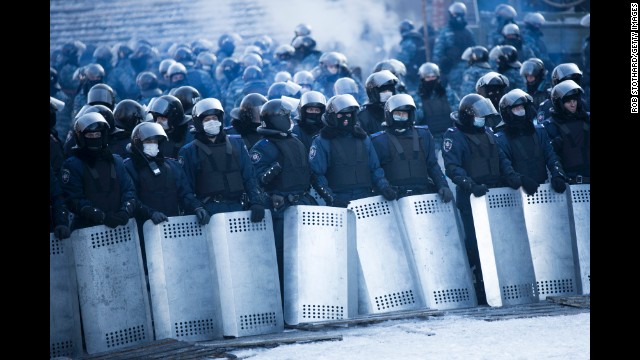 Riot police stand guard near Dynamo Stadium on January 24.
Riot police stand guard near Dynamo Stadium on January 24.
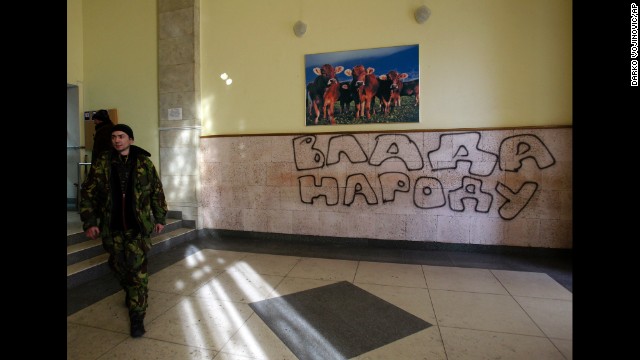 A protester passes past graffiti that reads “Government for People” in the Ministry of Agricultural Policy building in Kiev on January 24.
A protester passes past graffiti that reads “Government for People” in the Ministry of Agricultural Policy building in Kiev on January 24.
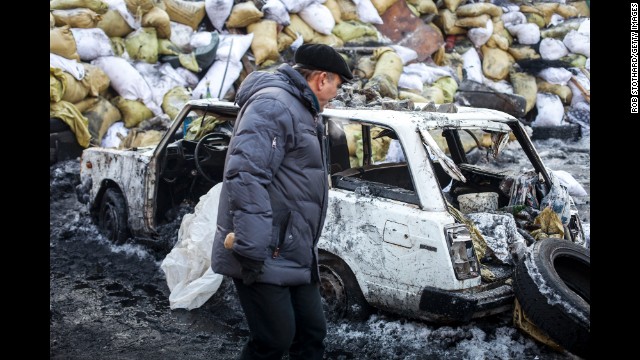 A man walks past the wreckage of a car on January 24.
A man walks past the wreckage of a car on January 24.
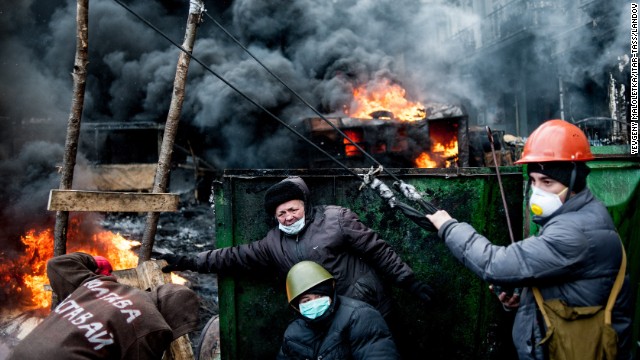 Ukrainian protesters use a huge catapult to throw stones at riot police as tires burn in Kiev on Thursday, January 23.
Ukrainian protesters use a huge catapult to throw stones at riot police as tires burn in Kiev on Thursday, January 23.
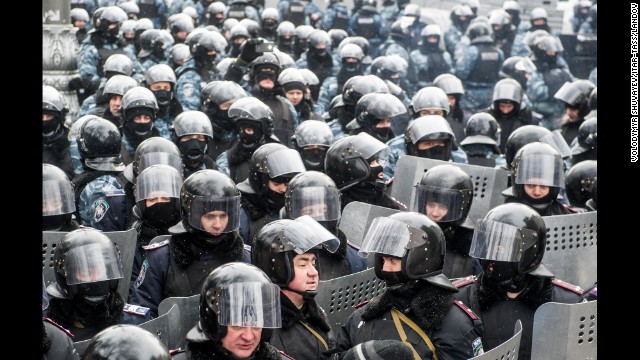 Riot police officers gather in Kiev on January 23.
Riot police officers gather in Kiev on January 23.
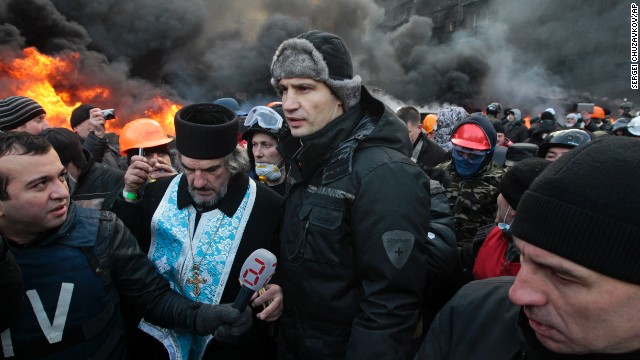 Opposition leader Vitali Klitschko, center, addresses protesters near the burning barricades between police and protesters in central Kiev on January 23.
Opposition leader Vitali Klitschko, center, addresses protesters near the burning barricades between police and protesters in central Kiev on January 23.
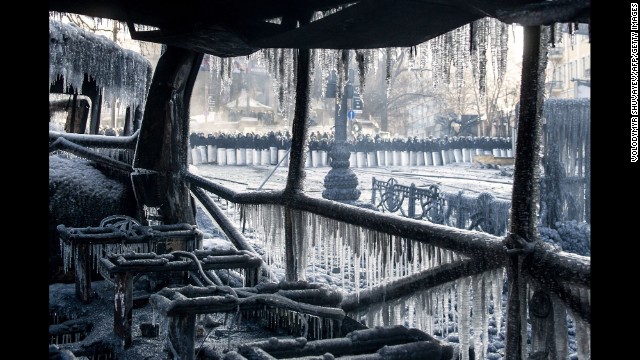 Riot police stand guard near a burnt-out bus covered in icicles in Kiev on January 23.
Riot police stand guard near a burnt-out bus covered in icicles in Kiev on January 23.
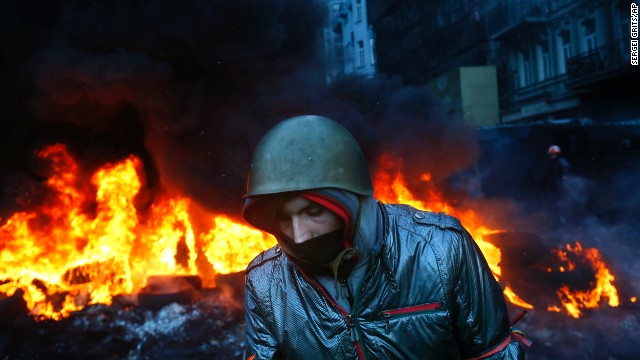 A protester walks past burning tires in Kiev on January 23.
A protester walks past burning tires in Kiev on January 23.
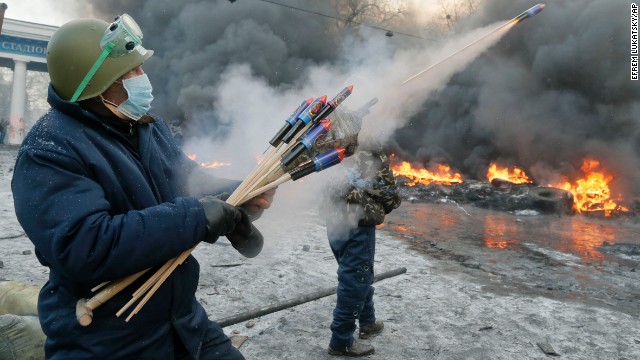 A protester shoots fireworks at police during clashes in Kiev on January 23.
A protester shoots fireworks at police during clashes in Kiev on January 23.
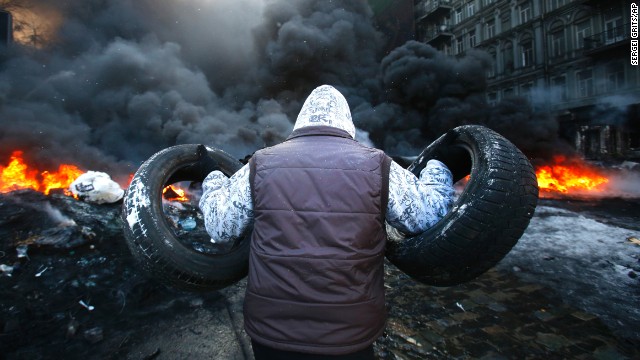 A protester carries tires toward a fire on January 23.
A protester carries tires toward a fire on January 23.
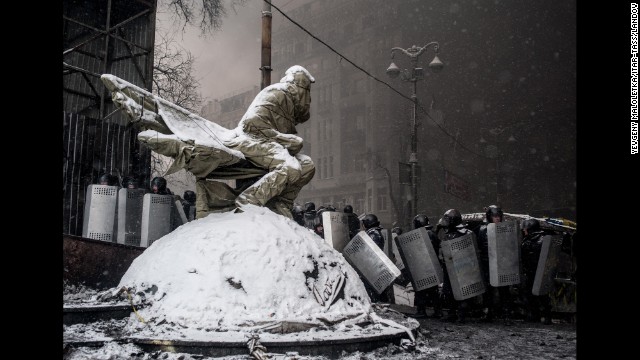 Riot police officers line up in Kiev during clashes on Wednesday, January 22.
Riot police officers line up in Kiev during clashes on Wednesday, January 22.
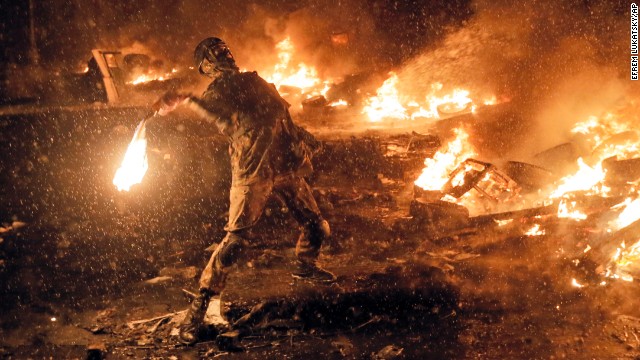 A protester throws a Molotov cocktail on January 22.
A protester throws a Molotov cocktail on January 22.
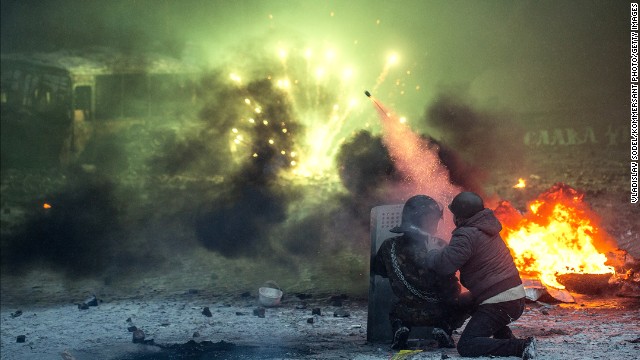 Protesters shoot from behind a shield among burning automobile tires in Kiev on January 22.
Protesters shoot from behind a shield among burning automobile tires in Kiev on January 22.
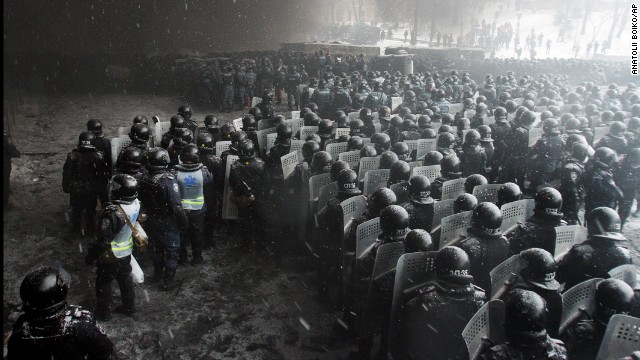 Riot police officers gather as they clash with protesters in the center of Kiev on January 22.
Riot police officers gather as they clash with protesters in the center of Kiev on January 22.
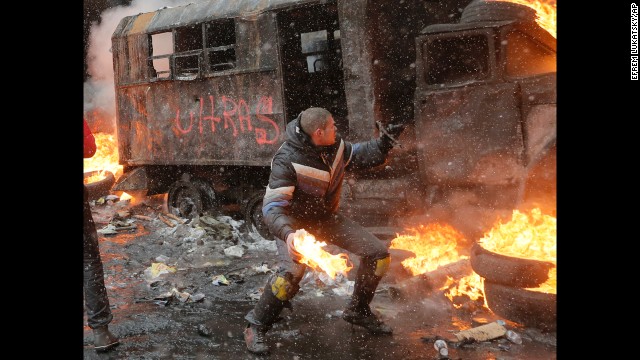 A protester throws a Molotov cocktail during clashes with police in central Kiev.
A protester throws a Molotov cocktail during clashes with police in central Kiev.
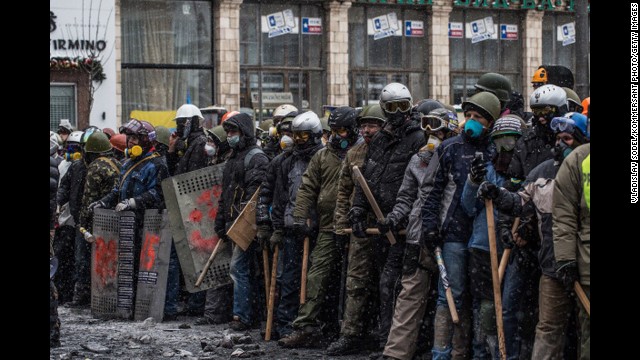 Ukrainian protesters are seem during a mass action of opposition on Grushevsky Street.
Ukrainian protesters are seem during a mass action of opposition on Grushevsky Street.
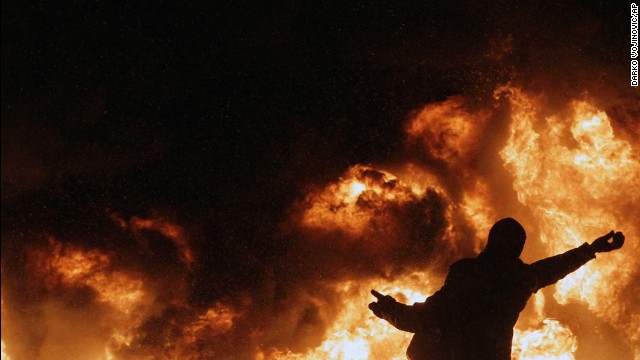 A protester throws a stone in front of a plume of fire and smoke during clashes with police in central Kiev.
A protester throws a stone in front of a plume of fire and smoke during clashes with police in central Kiev.
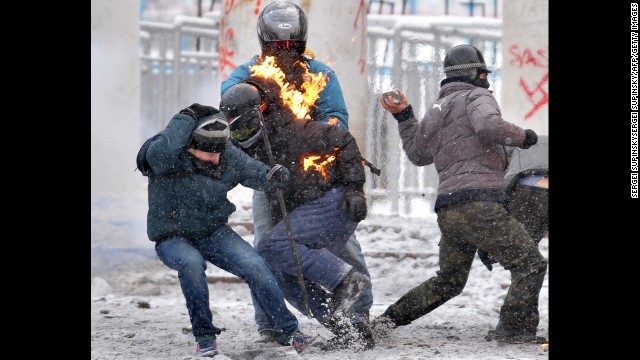 Flames leap off a protester during clashes with police on January 22.
Flames leap off a protester during clashes with police on January 22.
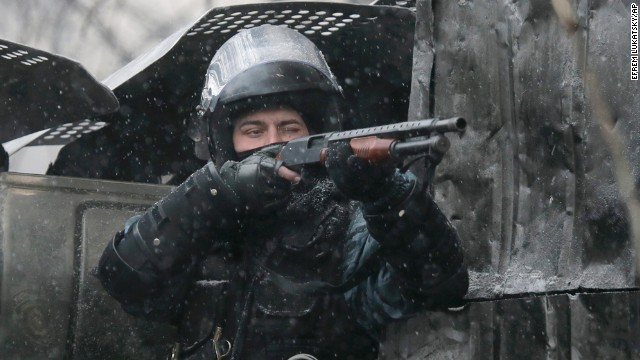 A police officer aims his shotgun during clashes with protesters.
A police officer aims his shotgun during clashes with protesters.
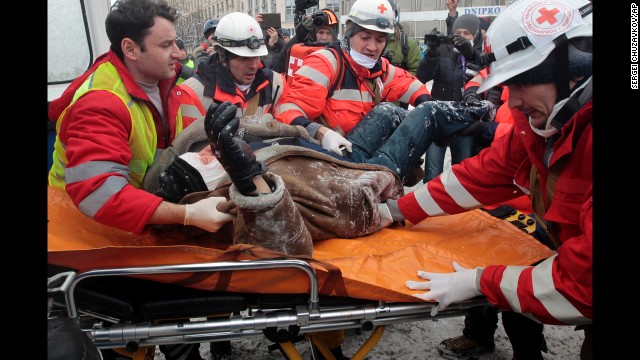 Paramedics put a wounded man on a stretcher and into a medical vehicle.
Paramedics put a wounded man on a stretcher and into a medical vehicle.
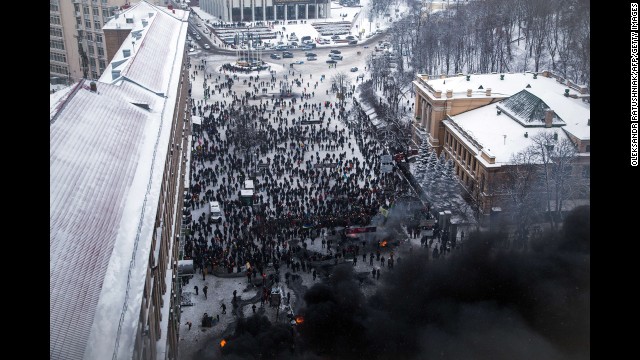 Ukrainian police storm protesters’ barricades in Kiev amid violent clashes on January 22.
Ukrainian police storm protesters’ barricades in Kiev amid violent clashes on January 22.
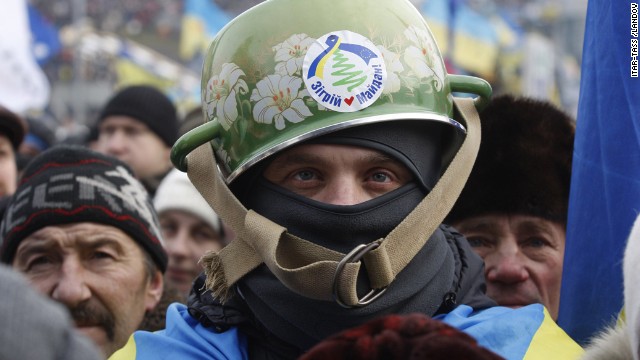 A European integration supporter is seen in Independence Square.
A European integration supporter is seen in Independence Square.
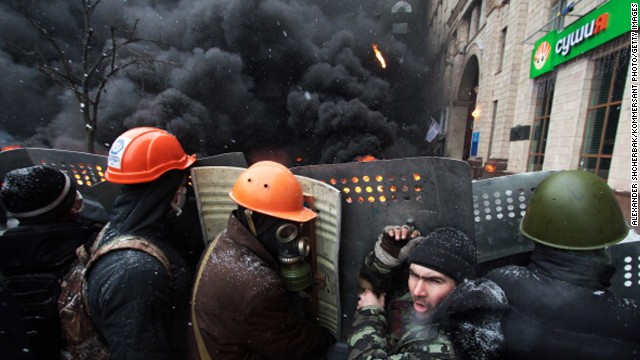 Protesters are seen in front of burning tires on Grushevsky Street.
Protesters are seen in front of burning tires on Grushevsky Street.
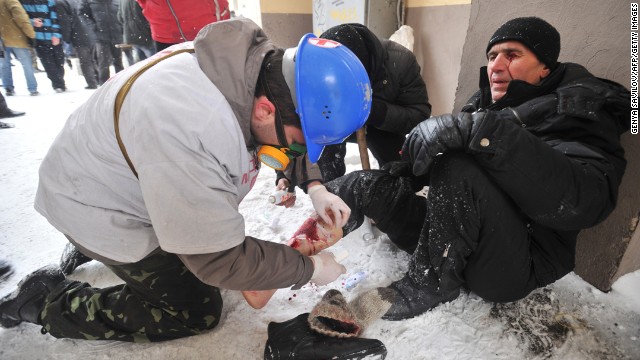 A medic treats an injured protester’s leg during violent clashes between demonstrators and police.
A medic treats an injured protester’s leg during violent clashes between demonstrators and police.
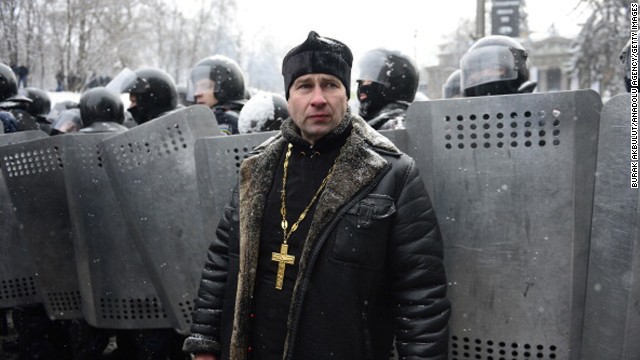 A Ukrainian man stands in front of riot police on January 22.
A Ukrainian man stands in front of riot police on January 22.
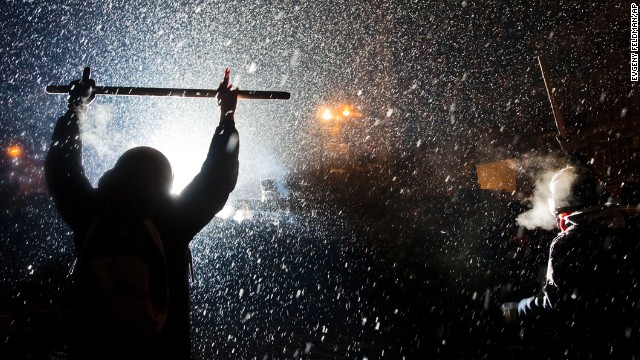 Protesters clash with police in Kiev as snow falls on January 22.
Protesters clash with police in Kiev as snow falls on January 22.

1

2

3

4

5

6

7

8

9

10

11

12

13

14

15

16

17

18

19

20

21

22

23

24

25

26

27

28

29

30

31

32

33

34

35

36

37

38

39

40

41

42

43

44

45

46

47

48

49

50

51

52

53

54

55

56

57

58

59

60
(CNN) — For three months, they’ve staked their claim to Kiev’s Maidan, or Independence Square, and to Ukraine itself. We will leave only when you pull closer to the European Union, when you change the constitution, when you alter the government’s power structure, they have loudly insisted.
But why?
Why have thousands of protesters staked their lives, seemingly, on their desire for political change? And why has the government resisted their calls so vehemently?
Questions that relate to human nature, of people with strong interests or passions refusing to budge, can’t be answered easily. But a look at Ukraine’s distant and more recent history, as well as the players involved, can shed light on what’s going on and what might happen next:
Ukraine through a protester’s eyes
What makes Ukraine unique, important?
A nation of 45 million people, Ukraine is the biggest frontier nation separating Russia and the European Union.
Until 1991, it was part of the Soviet Union. But when that communist nation collapsed following the fall of the Berlin Wall, Ukraine — like several other Soviet states — was forced to reinvent itself.
But it didn’t do so alone.
Players outside took an interest and took action. Ukraine is something of a pawn between Russia and the West.
The European Union, with backing of the United States, has been working on its relations with former Soviet bloc countries for more than two decades, with the aim of restoring democratic rule and improving quality of life for Ukrainians.
It views the decision by Ukraine, the largest of the former republics, not to partner more with the EU as bowing to Russian pressure.
Russian President Vladimir Putin has denied that Moscow is exerting undue influence in Ukraine.
Last month, he insisted, “Russia has always respected, is respecting and will respect the sovereign rights of all the international entities including new states that emerged after breakdown of the Soviet Union.”
But many don’t believe him, claiming that his government’s offers of aid to Ukraine constitute meddling in an attempt to tighten ties between the former Soviet states.
This alignment hurts Ukraine, these opposition activists say. Whereas other states, like Poland, that were once under Soviet control only to turn later more toward the West have thrived, Ukraine’s economy has stumbled.
Its government has also been slow to embrace Western ideals when it comes to politics and human rights, not to mention good governance: Ukraine is ranked 144 out of 177 countries in Transparency International’s corruption index.
Why are Russia and the EU central to the protest?
The recent protests are a byproduct in large part of the East-West tensions in Ukraine. The pro-European camp is stronger in Ukraine’s west, while the eastern part of the nation aligns more closely with Russia.
In November, thousands spilled onto the streets after President Viktor Yanukovych did a U-turn over a trade pact with the European Union that had been years in the making — favoring closer relations with Russia instead.
Angered by this backpedaling, the demonstrators demanded the EU deal be signed, saying it would strengthen cooperation with the bloc.
Their daily protests soon escalated, drawing parallels to Ukraine’s 2004 Orange Revolution that toppled the government.
But with Ukraine desperately in need of a cash injection, Kiev cited the need for financial assistance if it were to do business with the EU. Yanukovych, who has been in power since 2010, said that Ukraine could not afford to sign the EU deal — alluding to economic pressure from Russia.
Another factor in Yanukovych’s decision not to sign the deal is likely to have been the EU’s demands that he release from jail former Prime Minister Yulia Tymoshenko, his political opponent. The Orange Revolution that swept then-prime minister Yanukovych out in 2004 also brought Tymoshenko to power.
“The changes that occurred after the Orange Revolution weren’t simply deep enough. This time around, it appears that the disenchantment is so strong that there is a genuine opportunity to make a fresh start,” said Dalibor Rohac, policy analyst with the Cato Institute’s Center for Global Liberty and Prosperity.
“For Ukrainians this is a chance to get on a different trajectory from the one the country has been on for the past 22 years and become eventually a part of prosperous, democratic Europe.”
Tellingly, the European Union and particularly the United States have been outspoken in support of protesters.
On the flip side, Russia has backed Ukraine’s government. Calling protesters’ actions setting up barricades and more as “provocative steps,” Russia’s foreign ministry expressed “hope the opposition in Ukraine will renounce threats and ultimatums.”
What about talk of constitutional reform?
The disputes aren’t just about money or whether Ukraine aligns more with the European Union or Russia. It’s also about power.
Yes, many in the opposition have called for the ouster of Yanukovych and the ordering of new elections.
But both on the streets and in parliament, they’ve also pushed to alter the government’s overall power structure, feeling that too much of it rests with Yanukovych and not enough with parliament.
That thinking has been behind numerous opposition proposals in recent weeks to alter Ukraine’s laws and, more fundamentally, its constitution.
The government has offered some concessions, but not enough to satisfy the opposition.
Yanukovych has hardly loosened his grip on the government, nor has he seemingly reined in authorities’ approach to protesters — as evidenced by intensified clashes in recent weeks.
Why has the situation grown more tense?
Whatever his exact motivation, after backing away from the EU deal, Yanukovych flew to Moscow, where he and Putin announced Russia would buy $15 billion in Ukrainian debt and slash the price Kiev pays for its gas.
That move upset demonstrators. But what inflamed them even more was the adoption of a sweeping anti-protest law in mid-January.
The new law included provisions barring people from wearing helmets and masks to rallies and from setting up tents or sound equipment without prior police permission.
This sparked concerns it could be used to put down demonstrations and deny people the right to free speech — and clashes soon escalated.
That includes not only occupying Kiev’s central Independence Square, but also blocking other streets and government buildings. The demonstrators took over City Hall for the better part of three months.
Amid intense pressure, deputies loyal to Yanukovych backtracked and overturned that anti-protest law.
The protests continued, as did on-again, off-again conversations between opposition and government officials.
On Sunday, protesters vacated Kiev’s City Hall, unblocked a major street and left other government buildings in exchange for the government dropping charges against those arrested, opposition parliament member Arsen Avakov said. This came two days after the country’s attorney general announced that 243 protesters had been freed, though charges against them remained.
Any breakthrough was a distant memory by Tuesday. The speaker of parliament’s refusal to allow amendments that would have limited the president’s powers and restored the constitution to what it was in 2004 angered many in the opposition.
Whoever started them, fresh clashes ensued on the streets of Kiev, leading to at least 19 deaths by early Wednesday.
As Arseniy Yatsenyuk, an opposition leader, urged Yanukovych to “pull back the police and announce a cease-fire” so negotiations could resume, the government pinned the blame for the latest violence squarely on protesters.
“The truce has been broken,” said prosecutor general Viktor Pshonka. “For the sake of pursuing their own political interests, they neglected all previously reached agreements and put lives and the peace of millions of Kiev residents under threat.”
Ukraine protests – 5 things you need to know
Who makes up the opposition?
Without doubt, Yanukovych is the face of the Ukrainian government. Other than a few days he took off to fight off a respiratory infection, Yanukovych has been leading the way in dealing with the domestic and international aspects of the crisis.
In addition to controlling his government, his allies in parliament have done numerous things in recent weeks that have inflamed the opposition and also attempted (unsuccessfully) to assuage them.
So who is the opposition that Yanukovych and his allies are at odds with?
It’s not just one figure, but a coalition.
The biggest and most well known figure is Vitali Klitschko. A former world champion boxer (just like his brother Wladimir), Klitschko heads the Ukrainian Democratic Alliance for Reforms party.
In a sign of his influence, it was Klitschko who went to Yanukovych’s office late Tuesday for talks, according to his spokesperson.
But the oppositon bloc goes well beyond Klitschko.
Yatsenyuk heads the Fatherland party. And Oleh Tiahnybok is the leader of the Freedom party, or Svoboda.
These opposition leaders have been talking with Yanukovych’s camp.
In late January, the president offered a package of concessions under which Yatsenyuk would have become the prime minister and, under the president’s offer, been able to dismiss the government.
He also offered Klitschko the post of deputy prime minister on humanitarian issues and also agreed to a working group looking at changes to the constitution. But the opposition refused.
“No deal @ua_yanukovych, we’re finishing what we started. The people decide our leaders, not you,” Yatsenyuk tweeted.
Why Ukraine’s future lies with the EU, not Russia
What’s been the impact of crisis outside Ukraine?
February was supposed to be Russia’s — and, by connection, Putin’s — chance to shine with the Winter Olympics in the Black Sea city of Sochi.
Instead, the spiraling Ukraine unrest has snared some of that attention, as well as increased the focus on the Russian government’s part in it.
The ordeal has also shone a spotlight on seeming discord within the ranks of the opposition’s international allies.
A leaked audio recording of a phone call allegedly catches a U.S. diplomat to Europe using profanity to express strong frustrations with inaction and indecision by the European Union in resolving the crisis.
U.S. officials suggested that Moscow probably tapped a call — believed to include State Department official Victoria Nuland and U.S. Ambassador to Ukraine Geoffrey Pyatt — and leaked it out of concern about a potential deal between the government and opposition. The recording was posted to YouTube.
In the conversation, a man refers to Klitschko as the opposition’s “top dog” but suggests he’s too inexperienced to hold a government post. A woman who sounds like Nuland (though neither she nor the State Department confirmed it’s her voice) then refers to a perceived lack of pressure that the European Union is exerting on Yanukovych, stating, “f**k the EU.”
German Chancellor Angela Merkel called the use of such language “unacceptable,” according to a spokeswoman.
What’s next?
Opposition and government leaders have talked for weeks. Top international diplomats have been involved in trying to resolve the crisis.
And yet, seemingly, it’s only gotten worse.
One open-ended question is how much worse will it get. Assuming they back off, what tools and techniques will authorities use to clamp down on dissenters? Might the government and/or the opposition accept concessions to end this all peacefully?
All good questions, all seemingly impossible to answer at this point.
Regardless, the world is watching.
CNN’s Antonia Mortensen contributed to this report


